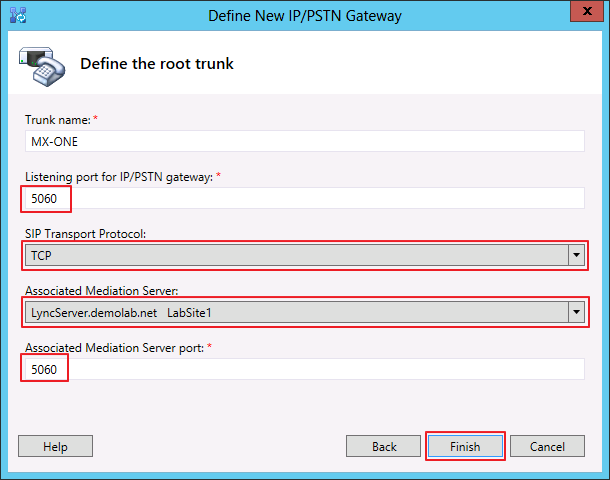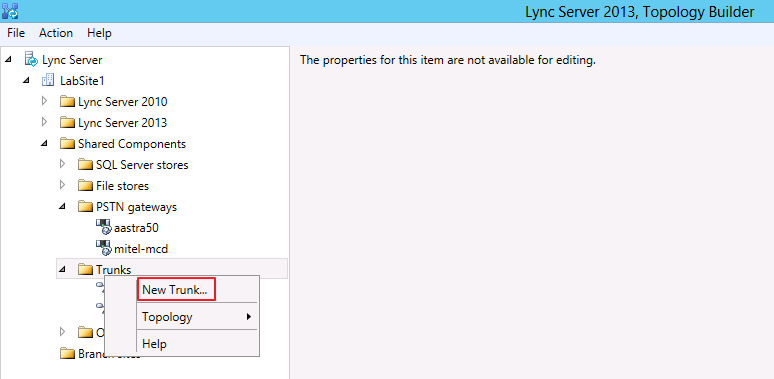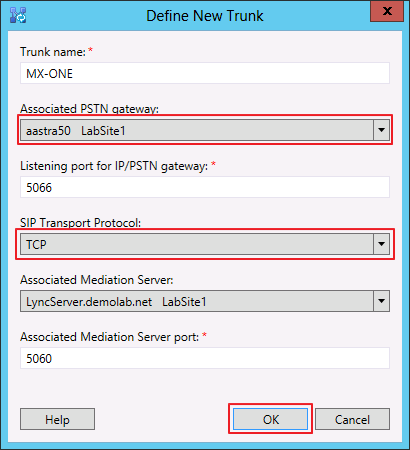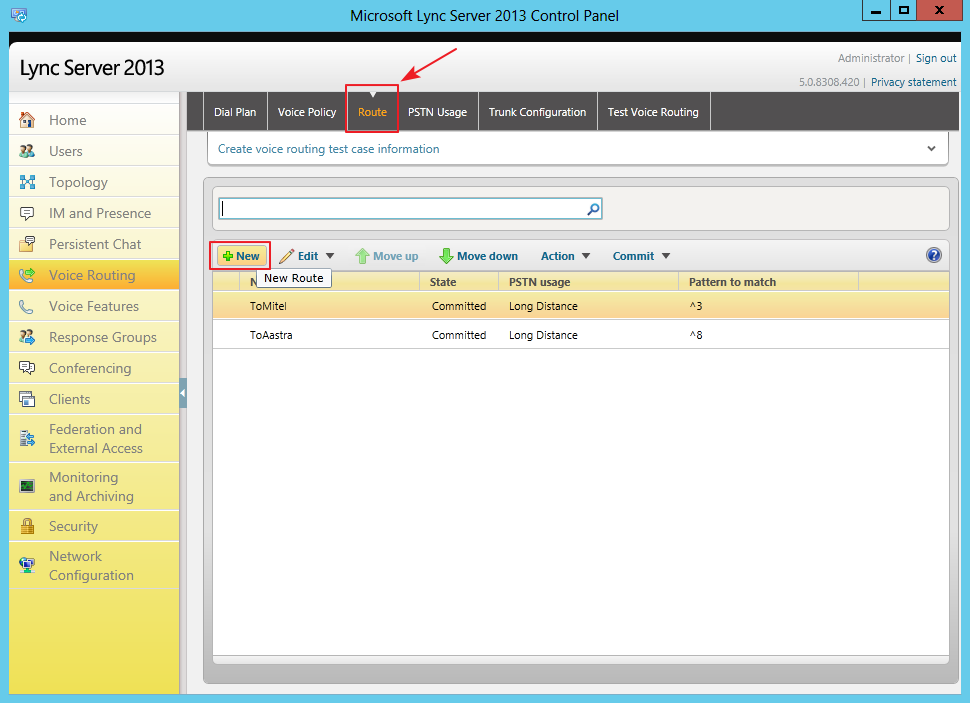MS Lync 2013 integration with Aastra MX-ONE 5.0 (Direct SIP)
In this post I will continue the topic of unified communications, started in my blog here: http://habrahabr.ru/post/191852/
This article will discuss the integration of MS Lync 2013 Server unified communications system with its external IP-PBX Aastra MX-One 5.0 TSE. The main goal of this integration is to provide communication with the “external” world to MS Lync 2013 users. Indeed, MS Lync 2013 provides its users with a large number of services, such as video calls, video conferences, short messaging, displaying their own screen or a separate application, but all this does not negate the need to make calls “to the city” (for example, via E1 lines brought to the organization) or calls to IP-PBX subscribers that already exist in the company or its branch.
The task is complicated by the fact that the basic voice codec of MS Lync is proprietary RT-Audio. All possible integration options with providers, IP-PBX, SBC and gateways are listed on the Microsoft website here: http://technet.microsoft.com/ru-RU/lync/gg131938 . We were a little embarrassed that at the time of writing this article there are no bundles of current MS Lync 2013 and Aastra MX-One 5.0 TSE, so in our Treolan laboratory we decided to check whether it is possible to link MS Lync 2013 Server and Aastra MX-One 5.0 TSE (vmWare edition) using Direct SIP, whose support on the Microsoft site is declared only for previous versions of these solutions (Lync 2010 and MX-One 4.1).
The following devices and virtual machines were used in the lab setup:
The numbering was adopted as follows:
Go to the settings of the SIP trunk. To do this, on the MX-ONE side, you need to set a route and an access code for this route. TCP is used as the transport protocol and the default port is 5060. For greater interoperability between MX-ONE and Lync Server 2013, Aastra recommends using “Forced Gateway” because this ensures the same behavior for all types of calls going through MX-ONE and Lync Server.
The following are the settings that must be made on MX-ONE to configure Direct SIP:
2.1 Description of PSTN gateways in Topology Builder
Go to the bookmarks - Shared Components → PSTN gateways / Trunks, right-click the machine, click on the tab, and select - New IP / PSTN Gateway.
')


Specify the fully qualified domain name (FQDN) or IP address for the PSTN gateway being created (in our case, this is the IP address of the Aastra MX-One 5.0 TSE media server:


Next, describe the root trunk:

Do the same for the Trunks tab (right-click and select - New Trunk ...

Specify the necessary parameters (Fig. 9):

After that, you must apply (publish) the changes made to the configuration by selecting - Publish Topology (right click on the Lync Server tab):

Open the Control Panel MS Lync Server 2013 and select - Voice Routing → Route. Click New to create a new route:

On the next screen, for the route to be created, you must specify the Associated Trunks by clicking Add ... and selecting from the list of available:

Next, we indicate the set, which numbers in the room will correspond to the choice of this route. For example, in this case, if the number starts with "3", then the call is routed to the appropriate trunk:

Open the MS Lync Server Control Panel and select - Voice Routing → Dial Plan. In the Associated Normalization Rules section, click New to create a new routing rule:

This example describes the following dialing rule:

At this setting is completed, you can make a test call from the subscriber Lyns to the subscriber Aastra MX-One 5.0 TSE. Also, in the future, using standard Aastra MX-One 5.0 TSE tools, you can route calls to MS Lync 2013 subscribers, for example, to its E1 trunks or analog trunks, thereby solving the problem of Lync subscribers going to the “city”.
PS: The solution described in the article was implemented together with habrouser mrppa
This article will discuss the integration of MS Lync 2013 Server unified communications system with its external IP-PBX Aastra MX-One 5.0 TSE. The main goal of this integration is to provide communication with the “external” world to MS Lync 2013 users. Indeed, MS Lync 2013 provides its users with a large number of services, such as video calls, video conferences, short messaging, displaying their own screen or a separate application, but all this does not negate the need to make calls “to the city” (for example, via E1 lines brought to the organization) or calls to IP-PBX subscribers that already exist in the company or its branch.
The task is complicated by the fact that the basic voice codec of MS Lync is proprietary RT-Audio. All possible integration options with providers, IP-PBX, SBC and gateways are listed on the Microsoft website here: http://technet.microsoft.com/ru-RU/lync/gg131938 . We were a little embarrassed that at the time of writing this article there are no bundles of current MS Lync 2013 and Aastra MX-One 5.0 TSE, so in our Treolan laboratory we decided to check whether it is possible to link MS Lync 2013 Server and Aastra MX-One 5.0 TSE (vmWare edition) using Direct SIP, whose support on the Microsoft site is declared only for previous versions of these solutions (Lync 2010 and MX-One 4.1).
The following devices and virtual machines were used in the lab setup:
- MX-ONE Telephony System v.5.0: 172.19.19.40 (virtual machine by vmWare ESXi 5.1
- MX-One Media Gateway Unit (MGU): 172.31.31.69 (networks 172.19.19.0/24 and 172.31.31.0/24 are routed)
- Microsoft Domain Controller, Active Directory, Certification Authority and DNS Server: 172.19.19.110
- Lync Server Standard Edition and Mediation pool 2013: 172.19.1911. In our example, the Mediation role is combined with the Front End Server, although this is not necessarily
The numbering was adopted as follows:
- Numbers on MX-ONE - 8xx
- Numbers on Lync Server 2013 - 5xx
Go to the settings of the SIP trunk. To do this, on the MX-ONE side, you need to set a route and an access code for this route. TCP is used as the transport protocol and the default port is 5060. For greater interoperability between MX-ONE and Lync Server 2013, Aastra recommends using “Forced Gateway” because this ensures the same behavior for all types of calls going through MX-ONE and Lync Server.
Step 1. Configure the SIP route on the MX-ONE side
The following are the settings that must be made on MX-ONE to configure Direct SIP:
# SIP route category: ROCAI:ROU=99,SEL=0110000000000010,SIG=0111110000A0,TRAF=03151515,TRM=4,SERV=0100000001,BCAP=001100; # SIP data category. VARC forced gateway RODAI:ROU=99,TYPE=TL66,VARC=00001000,VARI=00000000,VARO=00000950; # SIP trunk data specific. : sip_route -set -route 99 -remoteport 5068 -protocol tcp -uristring0 sip:?@172.19.19.111 # SIP trunk data specific. : sip_route -set -route 99 -accept REMOTE_IP -match 172.19.19.111 #Codec Filtering: sip_route -set -route 99 -codecs PCMA,PCMU # SIP Route -: ROEQI:ROU=99,TRU=1-1; # : RODDI:ROU=99,DEST=99,ADC=0005000000000250000001010000,SRT=3; Step 2. Configuring MS Lync Server 2013
2.1 Description of PSTN gateways in Topology Builder
Go to the bookmarks - Shared Components → PSTN gateways / Trunks, right-click the machine, click on the tab, and select - New IP / PSTN Gateway.
')


Specify the fully qualified domain name (FQDN) or IP address for the PSTN gateway being created (in our case, this is the IP address of the Aastra MX-One 5.0 TSE media server:


Next, describe the root trunk:
- Trunk name: MX-ONE
- Listening port for IP / PSTN gateway: 5060
- SIP Transport Protocol: TCP
- Associated Mediation Server: your_server_name
- Associated Mediation Server port: 5060

Do the same for the Trunks tab (right-click and select - New Trunk ...

Specify the necessary parameters (Fig. 9):
- Trunk name: MX-ONE
- Associated PSTN gateway: previously created
- SIP Transport Protocol: TCP

After that, you must apply (publish) the changes made to the configuration by selecting - Publish Topology (right click on the Lync Server tab):

Step 3. Description of the route in the Control Panel
Open the Control Panel MS Lync Server 2013 and select - Voice Routing → Route. Click New to create a new route:

On the next screen, for the route to be created, you must specify the Associated Trunks by clicking Add ... and selecting from the list of available:

Next, we indicate the set, which numbers in the room will correspond to the choice of this route. For example, in this case, if the number starts with "3", then the call is routed to the appropriate trunk:

Step 4. Description of the Dial Plan in the Control Panel
Open the MS Lync Server Control Panel and select - Voice Routing → Dial Plan. In the Associated Normalization Rules section, click New to create a new routing rule:

This example describes the following dialing rule:
- Name: MX-1
- Length: Exactly 3 - the exact length of the number, 3-digit
- Digits to remove: 0 - the number of digits to be cut from the number
- Pattern to match: ^ (8 \ d \ d) $ - check the number first, start with "8", then any 2nd digits from 0-9.

At this setting is completed, you can make a test call from the subscriber Lyns to the subscriber Aastra MX-One 5.0 TSE. Also, in the future, using standard Aastra MX-One 5.0 TSE tools, you can route calls to MS Lync 2013 subscribers, for example, to its E1 trunks or analog trunks, thereby solving the problem of Lync subscribers going to the “city”.
PS: The solution described in the article was implemented together with habrouser mrppa
Source: https://habr.com/ru/post/192036/
All Articles